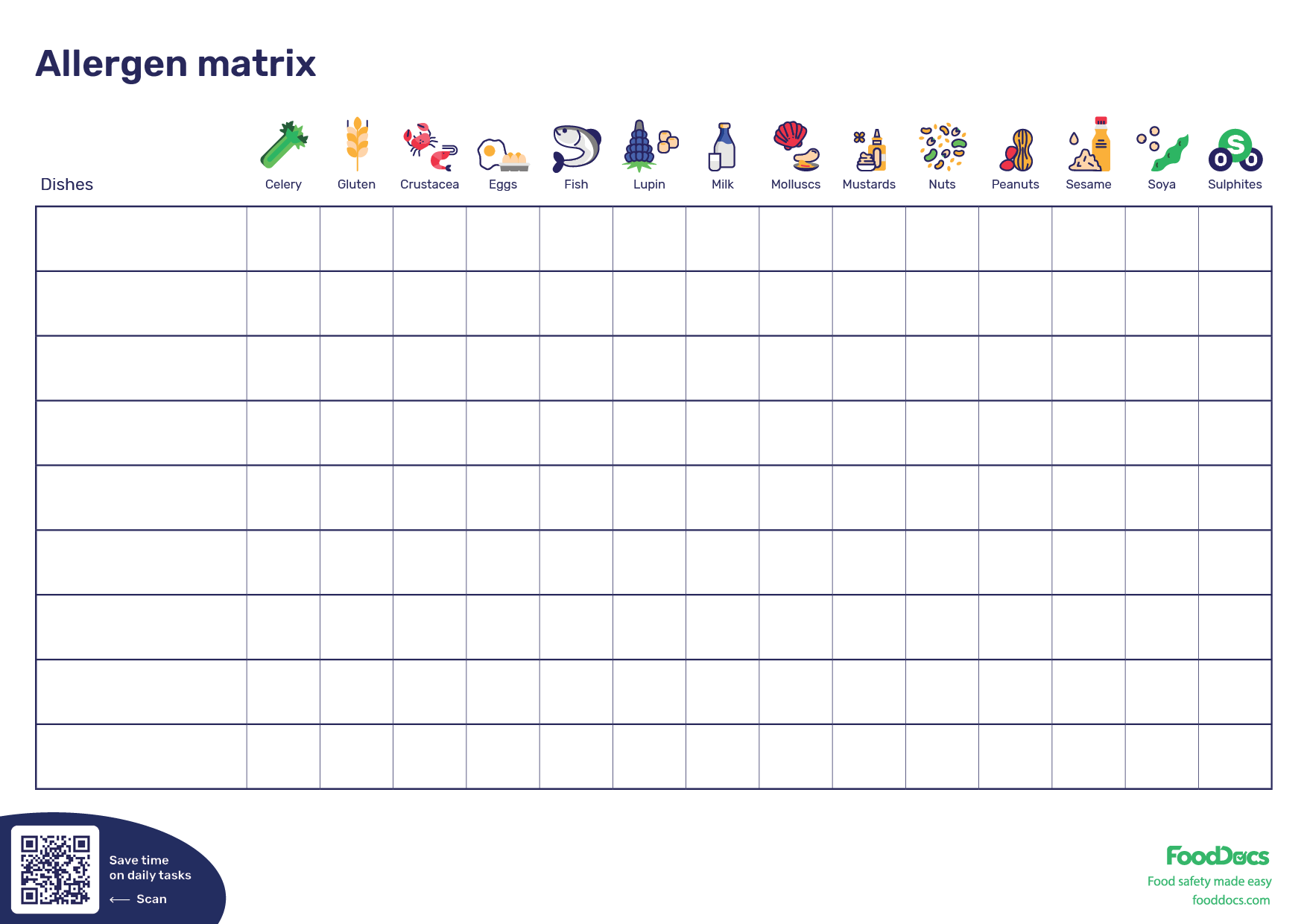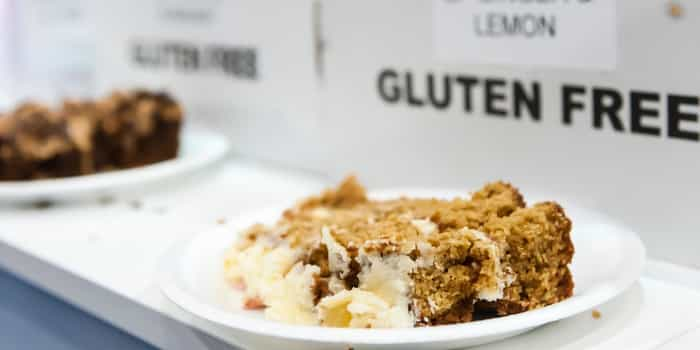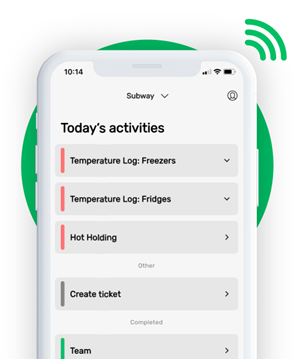ALLERGEN MATRIX TEMPLATE


This is how our Digital Food Safety platform saves 20% of your time on daily tasks:
- Get upcoming task notifications
- Add data into the app
- Check the status of tasks in real-time

When food safety was still handled on paper, I typically spent a couple of hours per day getting the papers and going around checking or completing tasks… Now I can sit down and it's just all there in one place. It takes me 5-10 minutes.
Ruth B.
Store Manager
In England, at least 1 out of 1,333 of the population has hypersensitivity to certain foods.
That's why your business must stay aware of the 14 major food allergens: celery, cereals (gluten), eggs, fish, lupin, crustaceans (prawns, crabs, etc.), milk, mollusks (mussels and oysters), peanuts, mustard, sesame, soybean, sulphur dioxide or Sulfites, and tree nuts.
Key takeaways
- In the UK, a significant portion of children have food allergies, emphasizing the need for thorough allergen safety in food establishments.
- Allergic reactions can range from mild symptoms like itching to severe reactions such as anaphylaxis, highlighting the importance of immediate and appropriate management.
- Using a food allergen matrix helps inform both food handlers and customers about the presence of allergens, which is critical for safety.
- The Food Standards Agency in the UK mandates specific labeling and information about food allergens, making compliance a legal obligation for food businesses.
- Key allergens include nuts, dairy, eggs, and seafood among others, and they must be clearly identified in food products.
- Food businesses must implement stringent practices to prevent cross-contamination of allergens in their operations.
- These tools are essential for easy communication of allergen information within the workplace and to customers.
- Allergen control is a critical part of the Hazard Analysis and Critical Control Points (HACCP) plan in food safety management.
- Regular training and updates are necessary to maintain food safety standards and manage allergens effectively.
- FoodDocs offers tools and expertise to help food businesses manage allergens effectively, including creating HACCP plans and food allergy documents.
WHAT WE'LL COVER:
- Introduction to Food Allergies and Allergen Safety
- Food Allergies in the UK
- Dishes and Their Allergen Content
- Best Practices for Food Allergen Control
- Who Needs a Food Allergy Form Template?
- How to Use a Food Allergy Chart?
- When Do I Need to Review an Allergy Chart?
- Food Allergen Control as a Critical Control Point
- How FoodDocs can help
Why a food allergy matrix is a necessity
In the UK alone, at least 6-8% of children up to the age of three are reported to have food allergies. This fact means that at least 1 out of 1,333 of England encountered hypersensitivity to certain food allergies. Because of this situation, agencies related to the food industry require and encourage establishments to have a food allergen matrix and show a stern commitment to allergen safety.
The effects of hypersensitivity to food allergens can have a range of degrees. Reactions can be light itching and rash, swelling of the lips, and sometimes nauseousness. In a more critical situation, some people with allergies can experience difficulty in breathing or even death due to asphyxia or prolonged lack of oxygen.
Whether a legal requirement or not, it is important for food business operators to inform the customers of the presence or absence of food allergens in the food. A food allergen matrix can help distribute the information to your food handlers or employees and customers alike.
Learn more about food allergy and a food allergen matrix in this article. Check all the other most popular HACCP plan documents in our free HACCP plan template hub.
Food allergies in the UK
In the United Kingdom, the Food Standards Agency is responsible for regulating food allergen labelling and other concerns such as guidance for food businesses and consumers. Allergic reactions to food allergens can be a very serious problem for food business owners.
A food allergy is a response of your immune system to a foreign body that it mistakes as a harmful substance. These foreign bodies are called allergens, which are usually proteins that can trigger hypersensitivity to susceptible individuals. In some cases, food allergens present themselves as additives such as sulfates.
People with food allergies must not take the negative reactions lightly. There are cases when adverse reactions occur.
The most common food allergy symptoms are:
- Tingling or itching in the mouth
- Hives, itching, or eczema
- Swelling of the lips, face, tongue, and throat or other parts of the body
- Wheezing, nasal congestion, or trouble breathing
- Abdominal pain, diarrhea, nausea, or vomiting
- Dizziness, lightheadedness, or fainting
If you suspect you have a food allergy, it's always important to speak with your doctor about it. They will confirm your allergy with the help of allergy tests. Food allergies are not as hard to treat as foodborne illnesses but require immediate attention.
This point is where the food safety handler's job comes in. It is one of the many responsibilities of serving safe food to inform customers about any potential allergenic ingredient in your products. As such, proper orientation and food business awareness training of your employees regarding food allergies must be done.
Another way to ensure that food allergy information is well distributed is through a food allergy matrix that must be around your facilities at all times. Create your own food allergen sheets through our free food allergy matrix template.
Dishes and their allergen content
In reality, if you are going to steer clear of foods containing allergenic proteins, you would end up eating nothing. These allergens can be present in many types of foods but are only highly concentrated in some. This fact is why the FSA has identified at least 14 food allergens by food law that commonly trigger potentially dangerous food allergy reactions.
These common food allergen ingredients include:
- Celery
- cereals (gluten)
- Eggs
- Fish
- Lupin
- Crustaceans (prawns, crabs, etc.)
- Milk
- Molluscs (mussels and oysters)
- Peanuts
- Mustard
- Sesame
- Soybean
- Sulphur dioxide or Sulfites
- Tree nuts

Food allergies may come from these food products or dishes that contain them even in small amounts. These high-risk food allergens contain particular proteins in them that some individuals have a negative affinity to. The allergenicity of food proteins varies from one individual to another.
Without proper allergen information and prior notice, customers with food allergies can unknowingly consume foods with these allergens. This situation can be bad for business. A common unperceivable allergen is sulfites. This additive is usually used in low acid foods such as pickled products, juices, jams, and also in canned vegetables, sauces, and molasses. Sulfites are used to control food discoloration and growth of microorganisms in a certain food type but have been reported to cause hypersensitivities to some individuals.
Allergic reaction to sulfites can cause wheezing, allergic rhinitis, hives, and in some cases, anaphylaxis or lack of oxygen. What makes sulfites dangerous is you cannot perceive any sensory characteristics of this compound. It has no taste, smell, or color. This is why proper allergen labelling rules are very important.
In the UK, it has been estimated that at least 5-8% of the population is composed of children with food allergies, and 1 in 55 children have a specific allergy to peanuts. The other most common food allergy in the UK includes allergy to milk and eggs. These foods can easily be found in any complex food such as chocolates, baby food, ice creams, feeding formula, and others.
Best practices for food allergen control
Allergens can always be a part of the food industry and is a continuous concern for customers with food allergies. Exposure to food allergens can be prevented or minimized by food handlers through proper food safety practices.
Make allergy control program a part of your HACCP food safety plan by following these steps:
- Properly label packed foods to inform consumers of potential food allergens in your products. This is especially important for food establishments offering takeaways.
- Include an allergen declaration statement in your menu, on-site or online.
- Conduct orientation and provide business awareness training resources to acquaint your food handlers with the necessary information about the aspects of food allergy.
- Avoid cross-contamination in the working area. It cannot be helped, especially for big companies, to have non-allergenic products at the same time as allergenic ones. In this case, cross-contamination can be very common but must not be allowed. The maintenance of food safety practices for food businesses must always be a priority at all times.
- Always conduct pre and post-operational cleaning and sanitation to ensure that no cross-contamination will occur.
- Always conduct pre and post-operational cleaning and sanitation to ensure that no cross-contamination will occur.
- Prepare a 14 allergens template poster to serve as an allergen checklist.
- Keep a food allergen sheet or allergy matrix near your working and service areas to remind people, employees, and customers alike, about the presence of food allergens in your food item.
What are food allergen sheets?
A food allergy chart enables you to see at a glance which dishes on your menu contain any allergens and which don't. It's a document where all the menu and allergens are listed, so you get a simple overview of all the necessary information.
The importance of constantly reminding your employees and customers of the significance of food allergens cannot be understated. One of the best ways to do this is to keep a food allergen sheet around your working area.
A food allergy chart is not an official part of allergen information regulations, but it can make your life easier when informing customers. As your team is busy serving customers, you should do your best to make life easier for them. It can be challenging for your team to keep in mind all food allergens when the menu is changing, particularly when your team is seasonal.
Food allergen sheets or a food allergy matrix must be specific to your business, flexible, complete, and informative. The best way to achieve these characteristics is to make one your own. Try our free food allergy chart template and start making one for your business.

Who needs a food allergen matrix template?
For any food businesses in the manufacturing and catering industry that are selling products containing allergens, it is required by a food safety law to inform your customers about them. It applies to restaurants, fast-food trucks, take-aways, shops, bakeries, etc.
Labelling of food allergen requirements, as declared by the Food Standards Agency in the UK, demands all food establishments to declare food allergens in their foods.
Foods and directives that are under this jurisdiction include:
- Prepacked foods - products that are packed before being sold which may be fully or partly enclosed. This term refers to products that must be opened before consumption and are ready for sale. Complete food labelling must be placed in a visible area before putting the product on sale.
- Non-prepacked (loose) foods - products that do not have any packaging such as baked goods and ala carte dishes. In this situation, your menu or product list must have the necessary food allergen information. In case the food allergen menu matrix is not available, staff must disclose information to consumers about any potential allergens in your non-prepacked (loose) food products.
- Prepacked for direct sale - food products under this category are packed in the same location where they are sold. Examples of prepacked foods for direct sale include sandwiches or burgers from a fast-food chain.
A complete ingredient list and declaration of allergen ingredients must be emphasized. Essentially, all food businesses required to declare major allergens in their products would benefit from a food allergen chart around your operations facilities and can become a vital part of your HACCP food safety plan.
How to use a food allergy chart?
You can use food allergen charts for both your team and your customers. Your food allergy matrix will be a comprehensive document containing all of your food products and the food allergens they may have.
A food allergy matrix can be pinned to your kitchen wall so your team can see it any time or print it out for each team member's pocket for peeking. For customers, it's not the most common way to inform them, but you can add needed comments about allergens directly to the menu.
Some examples of how to inform your customers and staff about major food allergens:
1. Add a clear advisory statement of allergens to each menu item. This method may be a bit unconventional for food establishments with rotating menus or when the products vary frequently. For a list of all your past and current menus online, this method is the best to use.
2. Add a general advisory statement to your menu that customers can ask for advice about food allergens from the staff. This will encourage consumers to be aware of the food they will be ordering. Train your employees to remind consumers when making a sale.
3. Add all allergen statements to your online menu and food delivery apps!
4. Keep a food allergy chart where all your staff can see it. For example, kitchen doors, walls, etc.
5. Consider adding your food allergens charts on your menus.
6. Follow standards for food allergen labeling by your local food authority.
7. Provide basic orientation programs and regular training to your employees about food safety to increase awareness for food businesses of the topic and prevention strategies.

Your 14 allergens template for a poster
In addition to a food allergy matrix, your establishment can also use a poster as an informative tool for consumers and employees. Build your own allergy matrix poster through our food allergy poster template for free.
Our food allergen poster contains the 14 major and minor food allergens. It also includes examples of where these allergens are usually found. Visual aids can help catch the attention of consumers and help them make better decisions fast. This can also prompt them to ask questions and recommendations from your staff for alternatives that do not have food allergens.
When do I need to review an allergy chart?
Several changes in your food establishment operations can require you to update your food allergy matrix. During such cases, it would be best to have a template that can be easily edited anytime and be printed for everyone to ensure allergen awareness.
Below are some cases that would require you to update your food allergy matrix:
1. Changes in your menu. Every time you change your menu, you are required to reevaluate your food allergy matrix to update the information on allergens. This is a mandatory step.
2. When you have a new supplier. New suppliers would mean that they may have different processing operations and other related products which may cause allergen cross-contamination in their supplies. Such cases call for a prompt reevaluation of their certificates of analysis and base your food allergen chart on this. Check all the ingredients you order, ask for product specifications when needed, and update your food allergy chart according to the menu.
3. When you use a substitute ingredient. There are times when you have to use substitute ingredients to fit a certain dietary requirement. In some cases such as in stores with specialized menus for vegetarians, information must on allergens such as soy and celery is very important.
4. When you have a new product.
Food allergen control is a critical control point
Food allergen management and allergen cross-contamination in your manufacturing operations are considered critical control points. Loss of control when understanding food allergens in these areas can have a significant impact on public health.
Cooking and other processing methods have varying effects on food allergens. Most often, they do not have any eliminating effects. As such, your food safety documents, together with the food allergy matrix have to be ready for an audit at any time.
Food allergen regulation is a vital part of food safety and your HACCP plan. In preparing your food allergen documents, the following supporting information is required:
- Preventive measure - your allergen control plan must have concrete measures and practices on how to prevent contamination in food preparation and adequate distribution of allergen information. One of the main documents under preventive measure is a food allergy matrix to inform everyone about the allergens in your products.
- Monitoring forms - needed to verify that there are no allergen cross-contamination.
- Corrective action - includes a list of solutions should non-compliance to standards on food allergen control occur.
- Traceability and recall plan - these documents become useful in cases where one of your consumers shows symptoms of allergy because of your products when no food allergen is declared. Once proven that contamination in food preparation occurred, a traceability plan for food fragments responsible for the allergic reaction report will help you map out the distribution channels and routes of this product and prevent further food safety offence.
Get an automated allergen matrix with FoodDocs to simplify allergen management
Not sure where to start with your food allergy documents? Don't have enough time? FoodDocs platform can direct you through the HACCP process and get your food allergy chart done in no time so you can focus on what you need to – managing your business.

At FoodDocs, we aim to give you the best experience in making your HACCP food safety plan or a food safety management system for your food business. Our HACCP plan builder combines the expertise of food safety consultants and the experiences of other food business operators. Through our built-in HACCP software, we can help you make your HACCP plan in 1 hour, only by answering choice questions.

One of our services offers you a downloadable food allergy chart template as well as a template for your food allergy poster. Build your informative documents using our templates that can easily be edited, downloaded, and printed for free.
Book a free demo call with our food safety experts to find out how you can benefit from FoodDocs' software.













